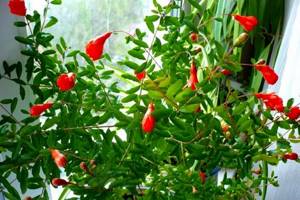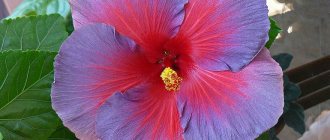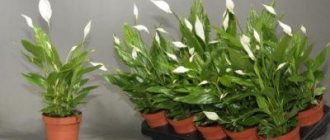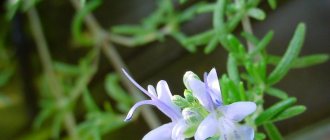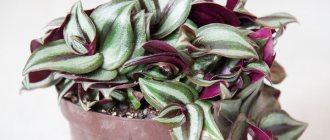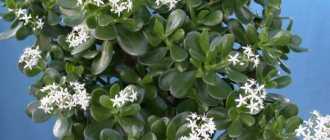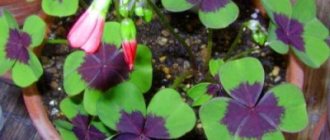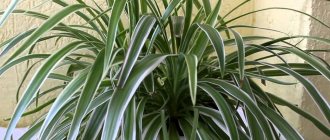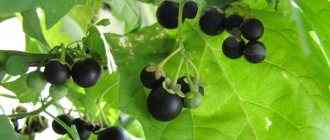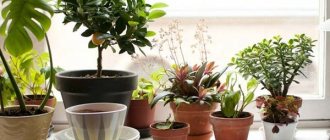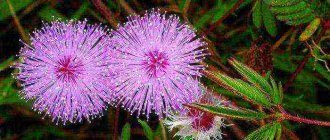Many Gesneriaceae are grown as beautiful flowering houseplants.
These species also include koleria, caring for which at home will not cause serious trouble, but the collection will add another green exhibit with bright bell-shaped flowers. In nature, the plant belonging to the Gesneriaceae family lives in the tropical regions of Central and South America. This is a perennial herbaceous shrub with thin, almost unbranched shoots, pubescent foliage and velvety tubular bells, which can delight the gardener almost all year round.
Features of the color in the photo and in the description
The ovoid-pointed leaves sit opposite on the shoots and, depending on the type and variety, can be not only green, but also purple, bluish or almost purple. The flowers of Kolerii, as in the photo, come in predominantly red and orange tones. But there are varieties with purple or pink bells. Variegated, speckled corollas are not uncommon. Flowers up to 4 cm in diameter are formed at the tops of the stems and are held on long peduncles.
If the plant is properly cared for on a regular basis, koleria at home responds with mass flowering, when 15–20 flowers open on one bush at a time.
Unlike the closest relatives of Gloxinia, which form tubers, Koleria develops a thickened, scaly rhizome under the soil cover.
Dipladenia
An indoor flower with red flowers, Dipladeniya is a climbing plant of the Kutrovaceae family. Among the varieties and varieties there are both annuals and perennials. Perennial species are grown indoors. Dipladenia is also called the Mexican love tree and the Brazilian balsam.
The shrub is very difficult to care for; not everyone manages to grow it at home. If the bush is grown on supports, then from a distance the dipladenia looks like a flower spiral.
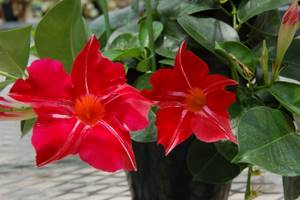
Dipladenia looks extremely impressive
The flowers have different colors from white to purple.
Additional information: the most beautiful varieties with scarlet buds: dipladeniya Blestyashchaya and Excellent.
Types of colors: photos of indoor crops
There are several dozen species of Koleria in nature, but only a small part is grown as a potted crop. This plant has differences:
- in crown size;
- in the color of foliage and flowers;
- in the place of growth in natural conditions.
Kohleria amabilis is distinguished by its dark green or brownish foliage with silvery dense hair. Stems, cuttings and veins have a purple tint. One, two, or less often three flowers open on the peduncles. The color of the corollas can vary from soft pink or orange to purple. The type of koleria shown in the photo often has two-colored corollas with a variegated, speckled throat.
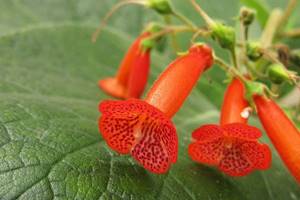
Kohleria eriantha is most often found indoors. The plants are easily identified by their olive-green, hairy leaves, which appear brown due to reddish hairs along the edges. The flowers of this type of kohleria, as in the photo, are predominantly bright orange-red in color. In the throat of the bell the shade changes to yellow. Red or burgundy spots are scattered across the petals. Several flowers open on peduncles at once.
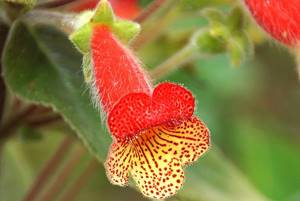
Kohleria bogotensis or, according to the alternative opinion of botanists, Kohleria amabilis var. Bogotensis, can be recognized by its green fluffy leaves and red-yellow flowers with burgundy speckles on the inner surface of the petals and throat.
In addition to the variety with an even green foliage color, there are specimens of this type of kohleria, as in the photo, that amaze the gardener with dark, brown-green foliage and the same shoots.
Varshewicz's Kohleria or Kohleria warszewiczii is another plant species that deserves the attention of indoor plant lovers. This large variety has the following colors:
- rather dense, erect stems of dark green color;
- pointed-elliptic leaves;
- unusual flowers with a lilac or pinkish tube and light yellow-green petals covered with purple or brownish specks.
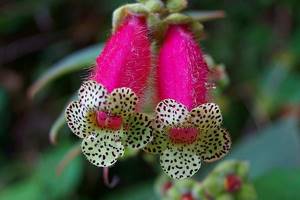
Another name often used for the species shown in the photo is Kohleria digitaliflora.
Indoor flower and plant with yellow flowers Primula (PRIMULA)
Primrose as a houseplant with yellow flowers can be grown as a crop to decorate window sills. This indoor plant with yellow flowers has excellent decorative properties. Garden primroses bloom in winter or spring in the center of a rosette of leaves or on tall peduncles. An indoor flower with yellow flowers of stemless and variable primrose can be planted in the garden after flowering. As a rule, heat-loving species are grown indoors, the flowers of which are smaller and located on peduncles above the leaves. P. soft and P. chinensis are very attractive. P. obraconical should not be touched with hands, as it can cause skin irritation.
Varieties
The stemless primrose, or common primrose (Primula acaulis), has flowers on very short petioles; P. variabilis has bright flowers on peduncles 30 cm long. The most popular heat-loving species is P. soft (P. malacoides) with fragrant flowers arranged in tiers on peduncles 45 cm long. P. obconica has fragrant flowers in a wide range of colors. P. chinensis has flowers with a yellow center and is usually red in color. P. kewensis is a heat-loving primrose with yellow flowers.
Care
Temperature: Cool - keep at 13-16°C during flowering period.
Light: Places that are as brightly lit as possible, but protected from direct sunlight.
Watering: Keep the substrate moist at all times during the flowering period.
Air humidity: Spray the foliage from time to time.
Post-flowering care: Plant P. acaulis and P. variabilis in the garden - other species are usually discarded. P. obconica and P sinensis can be saved - replanted and kept in light shade during the summer. Water very sparingly—resume normal watering in the fall.
Reproduction: By sowing seeds in mid-summer.
Home care for colonies
Koleria is one of the most unpretentious plants of the family. It grows and blooms at room temperatures without any problems. The plant loves light, but in the hot sun it can wilt, lose its decorative effect and drop flowers ahead of time, so it is better to provide shading for the southern windows during the midday hours. With a lack of sunlight, the shoots stretch out, become disproportionately thin and weakened. The leaves are getting smaller, the flowering is not encouraging in large numbers.
During the cold season, many plants shed their leaves, finish flowering, and over time their entire above-ground part dies off. In this case, it is better to reduce the air temperature by 5–7 °C and reduce watering, only occasionally moistening the soil. In the spring, when the roots show signs of awakening, the pots are exposed to light and the previous care for the plant is resumed.
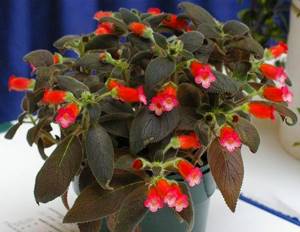
If the koleria, as in the photo, retains its foliage for the winter, it still needs light, regular, but not as abundant as in the summer, watering and a temperature of 16–18 °C.
In addition to watering and maintaining the optimal temperature, caring for koleria at home includes measures to humidify the air, which is especially useful on hot days and when the heating is on.
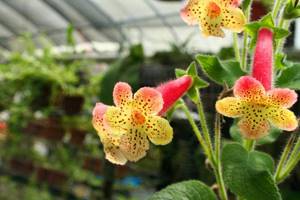
In the spring, the koleriyas are transplanted into nutritious loose soil. To do this, take a ready-made mixture for Saintpaulia or a universal substrate for flowering crops. Since the rhizomes of the plant are located shallow under the surface, it is better to choose wide, not too deep containers, at the bottom of which there must be drainage.
Decorative foliage flowers with red-variegated color
Any indoor plant with red leaves looks unusual and very beautiful, especially if the owner cares for it properly. And such a flower attracts a lot of attention, so the pot is usually placed in a prominent place, setting off the color of the upholstery, wallpaper or expensive curtains. Moreover, while some varieties have red foliage over the entire surface, others have a rich decorative tint only on top or on the sides.
Here are 5 of the most spectacular and popular names of ornamental crops with bright red or red-crimson, purple foliage:
- poinsettia;
- Cordyline;
- irezine;
- nidularium;
- triangular oxalis.
Poinsettia
A plant of the Euphorbia family, which has another name that has become popular among the people - “Christmas star”. This comparison is given for the bright red leaves at the top, which bloom closer to December, the New Year. The flower's homeland is Mexico and central America. There are many varieties of poinsettia, the most popular are:
- spherical;
- large-horned;
- sparkling.
On a note. In some subspecies, red leaves are located on top in the middle, in others they have a green surface, and are reddish only on the inside. There are also varieties with bright pink, white, even bluish “stars” in the center of the apical stem.
Caring for this beautiful poinsettia is not difficult. She does not like drafts and changes in room temperature, extreme heat, or darkening. Grows well in diffused light, responsive to spraying and regular watering. During the dormant period, it sheds its leaves and does not look very aesthetically pleasing. The Christmas star is propagated by cuttings, which should have 5 leaves. Often affected by scale insects and spider mites.
It is important to know that the milky juice of poinsettia is poisonous and causes skin irritation, so replanting and pruning it can only be done with thick gloves.
Cordilina
In appearance, this tropical plant, about 40-50 cm high, resembles a palm tree, but is not one. Cordyline is a subshrub of the Agave family, a close relative of Dracaena. This indoor flower is loved by its owners for its unusual long red leaves gathered into a dense crown. There are varieties with green, variegated red and white foliage, which also look impressive and attractive. Gradually, the lower leaves dry out and fall off, exposing the thin trunk.
Cordilina loves warmth, diffused light and infrequent watering. Does not tolerate direct sunlight, prefers to grow at temperatures of 20-23 degrees in summer, 13-17 degrees in winter. Overmoistening is detrimental to the plant, but the heat-loving cordyline responds to spraying and annual transplants with good growth.
Irezine
The perennial is easy to care for, loves diffused light, and grows well in any temperature conditions. It is practically not affected by pests, and even tolerates drought and dry air with heating running in winter.
Nidularium
An indoor flower of the bromeliad family native to the tropics of America. The plant is distinguished by the fact that it has no stem and is covered with sharp, serrated leaves at the edges. The peculiarity of Nidularium is its long red leaves that appear during flowering. After flowering, the beautiful rosette dies, forming several children on the sides. They also soon begin to bloom, which is why the flower grows quickly.
Caring for nidularium is simple; it consists of protecting it from direct sunlight and maintaining a high level of soil and air humidity.
Oxalis triangularis
When growing triangular oxalis with red leaves at home, the pot must be placed in a well-lit place, otherwise their color will become darker, closer to green. It is worth watering the soil as it dries, adding additional fertilizing in the form of liquid fertilizers in spring and summer. In winter, it is worth maintaining a period of rest so that the flower grows a lush crown and delights with its bright foliage.
When choosing an indoor flower not with green, but with reddish-variegated leaves of different shades, it is worth considering that the list of varieties is not so extensive. Some have variegated foliage of two or three shades, while others amaze the imagination with rich tints of colors in all reddish-green tones with white, yellow or purple streaks.
Here are the most popular names of decorative leafy crops:
- croton;
- coleus;
- aglaonema;
- royal begonia;
- cryptanthus;
- hypoesthes;
- caladium.
Home care rules
- We choose a place . It is better to place the koleria on the windowsill of a window facing east or west. The flower does not like too bright sun, because this can lead to loss of color of the leaves, and the lack of light causes the stems of the plant to become thin and long, because of this it will grow weak and ugly.
- Conventional soils can be used for it , but they must be drained.
- It does not tolerate cold . The minimum growing temperature should be no lower than 15 degrees, the maximum no more than 27 degrees.
- Watering should be done as the soil in the pot dries. You should not allow excess moisture in the soil, as this can lead to the appearance of harmful fungi that will harm the plant. The frequency of watering in summer is 3-5 days, less often in winter, but if the window sill is located above the radiators, this can lead to rapid drying of the soil. This should be monitored closely.
- The flower can grow in dry air because the plant is hardy. But for its normal development it is better to humidify the air. How to do this? There are several ways:
- Place the pot on a tray and place wet stones around it.
- Place a cup of water next to the plant.
- Use special devices for moisturizing.
Classification of bell types: meadow and many others
Numerous types of bells are conventionally divided into groups according to various characteristics. Thus, in terms of life expectancy, the main part of them are perennials, a much smaller proportion are biennials, and several species are annuals.
Annuals are rare in our climate zone; they usually grow in more southern regions.
https://www.youtube.com/watch?v=ytpolicyandsafetyen-GB
From this group, annual bellflower is found in gardens.
An important classification feature that determines the characteristic biological properties of a plant, and, consequently, the features of caring for it, is its natural habitat. On this basis, all species are divided into field, forest and mountain.
They are somewhat capricious, need sun, calcareous soils and good drainage, but due to their miniature size and long flowering they are very popular. They are especially good for alpine slides; they also look good in curbs.
According to their height, bells are divided into tall, medium and low. Most forest species belong to the tall group; mountain varieties are usually compact in size.
The following are detailed descriptions of some of the most famous and commonly found species in our gardens, grouped by habitat in nature.
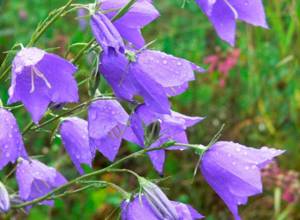
A large group of decorative bells consists of forest species.
The species grows in forests throughout Russia, but its numbers are constantly declining due to the uncontrolled collection of attractive inflorescences for bouquets. It has long been grown in garden culture, valued for its unpretentiousness, the ability to grow both in the sun and in the shade, on soils of any composition.
There are many garden forms and cultivars, differing in size and color of inflorescences.
The varieties are easily propagated by dividing the bush; the natural form is propagated by seeds.
In nature, this perennial grows in forests, bushes, along river banks and in shallows. Its straight, branching stems from above are densely pubescent; the leaves, petiolate, heart-shaped below and on non-flowering shoots, broadly lanceolate, sessile or with short stem petioles, are also covered with hard short pubescence.
The name of the species reflects the original appearance of its flower, large, in some cultivars up to 9 cm long, drooping, goblet-shaped, inside, and in some forms also outside, covered with bright crimson dots. Individual flowers are collected in a dense cluster and bloom in mid-summer.
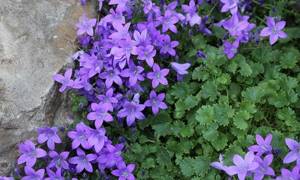
The natural form is white, cultivated varieties have a variety of colors: reddish in Othello, pink with a white edging and numerous purple dots in Cherry Bell, bright blue in the tall (up to 75 cm) cultivar Kent Bell.
This decorative bell is more whimsical than other types; it requires a sunny location, nutrient-rich non-acidic soils, sufficient moisture, and shelter for the winter. Due to the taproot system, it does not tolerate transplantation well, especially in adulthood. Propagated by seeds, often self-sows.
Despite some difficulties in care, it is popular among flower growers, looks impressive in garden compositions, and is suitable for cutting. Cultivated since the 16th century, numerous garden forms with simple and double flowers are painted in a wide variety of colors: white, blue, light blue, pink, purple.
https://www.youtube.com/watch?v=ytpressen-GB
Representatives of mountain species are also widely represented in decorative floriculture; these, mostly low-growing plants, are especially suitable for alpine hills and rocky gardens.
The plant feels great in the conditions of central Russia, where it successfully winters without shelter. Valued for its unusually long flowering period, beginning in June and lasting up to 70 days. Prefers a sunny or semi-shaded location, dry, well-drained soil, and requires virtually no watering.
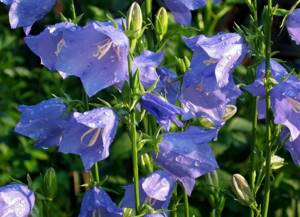
The plant produces abundant self-sowing and can be propagated by both seeds and layering.
Crown formation
If you want the plant to have a beautiful shape, it needs to form a crown. The same should be done with color.
Step-by-step instructions for crown formation:
- The crown of the koleria is not cut off, but plucked.
- It is better to do this procedure in the spring.
- If you don’t form a crown in time, it will grow like a bush in different directions, which looks ugly from the outside.
- The top of the plant should be plucked when it reaches a length of 20-30 cm.
- After this, the flower will release side stems, which will give it splendor.
- You need to remove the shoots from this indoor plant, because they will first pull up and then bend under their own weight. It will not look neat and ugly.
- You should not ignore dried and elongated branches; they must be removed in time.
- If there are dried leaves on the kaleria, they are also immediately removed.
Anthurium
This indoor plant has a unique appearance, which gave it its second name - “male happiness.” There is an opinion that anthurium strengthens masculine strength, brings good luck, and attracts financial well-being. This evergreen plant belongs to the araceae family.
In natural conditions - epiphytes, lithophytes. Not only the red flowers are decorative, but also the leaves; they are distinguished by a variety of sizes and shapes - whole and with cuts, from a few centimeters to a meter in length. The leaves have a beautiful color with a velvety or glossy sheen and silvery veins.
The most interesting thing about anthurium is its flowers, collected in a dense inflorescence resembling a cob. There is a blanket around the inflorescence; this leaf has a different color, including bright red.
Varieties with a red blanket:
- “Scherzera” - with long peduncles, a large bright red spathe, and a cob twisted into a spiral;
- "Turenza" is a lush bush with a rich yellow cob;
- “Dakota” is a large plant, reaching a height of 70 cm;
- "Sierra Magic" is a compact bush with small flowers, characterized by abundant flowering;
- 'Bugatti Veyron' is an elegant plant with a contrasting purple-gray ear.
The plant is capricious and needs special care.
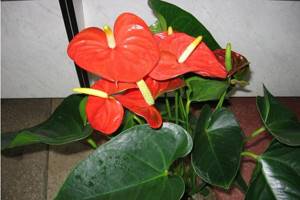
Reproduction
Exotic flowers are propagated using 3 methods:
- Propagation by cuttings occurs in the same way as by leaves.
- The koleria cutting produced both roots and rhizomes
Vegetative is a simple and popular method. The plant can be propagated by leaves or cuttings. This method is used to re-root a flower or rejuvenate it. The entire process of propagation of flowers by leaves can be described in several stages:
- Take a glass or a small jar and pour water into it.
- A plant leaf is placed in the prepared container.
- The container with the leaf should be covered with a cake lid or an empty plastic bottle.
- After the young branch has grown roots, the old leaf can be removed.
- The twig needs to be transplanted into a small pot.
- Seed . Seeds are purchased at the store and planted in a pot. The soil must be pre-fertilized with a special mineral complex. Watering is carried out periodically: once every 3 days.
- Rhizomes of Kolerii
Flower propagation by rhizomes . When a plant is transplanted from pot to pot, you can see small nodules in the soil - these are rhizomes. To reproduce, rhizomes are planted in the ground. A small hole is made in the ground, where the rhizome is placed and sprinkled with earth. The pot does not need to be placed in a greenhouse or covered; over time, the baby pots will crawl to the surface on their own. After the babies come out, they should get a little stronger, and then they can be seated.
Coleria transplantation
Flower transplantation is performed once every 3 years. This should be done in the spring.
Transfer order:
- First you need to prepare a container where the color will be transplanted.
- The new pot must be washed and dried.
- It is better to buy soil for replanting in advance at a flower shop. It is worth choosing special soil for rapidly growing flowers.
- Soil is poured into the pot.
- You need to make a hole in the ground.
- Coleria is planted in the resulting hole.
- The flower needs to be watered.
When replanting, you need to be careful and not rush, so as not to damage the roots of the delicate plant.
Diseases and pests
If the plant is not properly cared for, it may become sick or be affected by various types of pests.
Diseases:
Whiteflies
Pests:
- Whiteflies;
- Spider mites;
- Mealyworms;
- Thrips.
They must be destroyed using biological and chemical means.
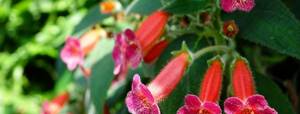
Kaleria is a beautiful, abundantly flowering plant native to the tropics. The unpretentiousness of the plant allows you to create beautiful hanging compositions at home. Simple rules of care can be followed by any gardener, even a beginner.
Hemigraphis
Hemigraphis is valued for its interesting leaves, but the flowers are not of particular interest - they are small and inconspicuous. When grown in the sun they take on a richer dark purple hue, while in the shade they become more silvery. A delicate plant requires careful care and maintenance of a suitable microclimate. The homeland of hemigraphis is the humid tropics, so the conditions in the room must be appropriate.
The care requirements of hemigraphis are as follows:
- Lighting: fully diffused, without direct rays. It is optimal to grow the crop on the western or eastern side of the house.
- Air humidity: high, it is useful to regularly spray with warm water, the use of humidifiers is encouraged. In summer, you can periodically arrange a shower.
- Temperature: in the warm period - 20-25 degrees Celsius, in the cold period - 18, not lower. Do not allow drafts, overheating or hypothermia.
- Watering: plentiful in the warm season, it is necessary to maintain moderate humidity, add moisture less often in winter.
- Reproduction: stem cuttings.
- It is necessary to pinch the shoots, otherwise the leaves will begin to shrink and the stems will stretch.
Description of the plant
Kaleria (coleria) belongs to the Gesneriaceae family and grows naturally in the tropics of equatorial America.
The leaves of the plant reach a length of 15 cm, their surface is covered with small red or white hair. The color varies depending on the type of flower (olive, bronze, silver, dark green leaves with light veins are found).
Abundant flowering is especially valued by gardeners who breed the plant. Bell-shaped flowers of various colors, usually with 5 petals, are arranged in 1–3 pieces. on the peduncle. Hybrids have cherry, amethyst and other interesting shades, but in nature this plant blooms with pink-white, red-orange, brown-white flowers. The petals are usually not monochromatic, but with a pattern - specks, strokes, stripes.
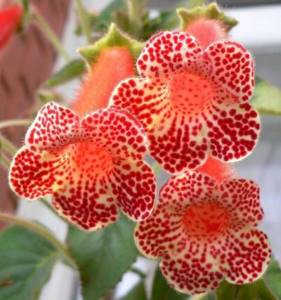
Kaleria flowers immediately attract attention
Kaleria is not picky about care, so it is easy to grow at home.
Main types of flower
- Fluffy-flowered. The plant is quite tall - up to 0.8 m in height, with green leaves covered with reddish hair. Bright red flowers with yellow dots on the petals are very impressive.
- Foxglove. The flowers are bell-shaped with a wide bend. The entire plant is covered with white hairs.
- Nice. The leaves are silver-green with purple veins. The flowers are pink, small - about 2 cm.
Photo gallery: different galleries
Table: what conditions of maintenance are required depending on the season
| Season | Lighting | Humidity | Temperature |
| Autumn winter | A well-lit place, with shade from direct sunlight. | Prefers moist air, although it tolerates dry air well. You need to spray the air around the plant, since the fleecy leaves of Kaleria react unfavorably to the ingress of water drops. Another way to provide the necessary humidity is to place the plant pot on a tray with damp pebbles. | 20–24 o C |
| Spring Summer | 17 o C |
Hippeastrum
This plant is often confused with amaryllis; they are relatives, belong to the same family, but represent different genera. Hippeastrum is a perennial bulbous plant with long glossy leaves growing up to 70 cm, arranged in two rows. A leaf plate with a shallow groove in the center.
The peduncle is powerful and tall. It contains funnel-shaped flowers; they have different colors, including red. Large flowers, reaching 20 cm in diameter, are collected in inflorescences.
At home, hybrid varieties are cultivated that have large and small flowers, double, regular, tubular, reminiscent of orchids. For bright lush flowering, a full period of rest is necessary. If this condition is not met, small buds appear on a short peduncle, or the hippeastrum may not bloom at all. The smell is practically inaudible.
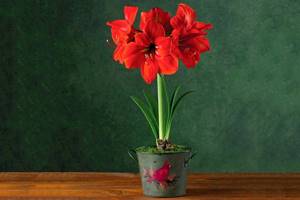
Landing
Kaleria in the wild grows on rocky, poor soils, so it is not very demanding on the soil. Replant it if the rhizome has already completely filled the pot. The best time for transplantation (more precisely, for transshipment) is spring. For the plant you should take a shallow and wide container.
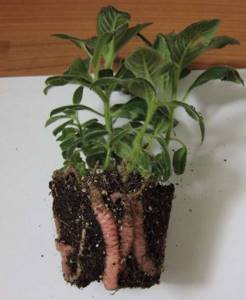
Kaleria is transplanted using the transshipment method
Earth mixture: 2 parts leaf soil, 1 part peat, 1 part sand, 0.5 parts humus, a little charcoal (to absorb excess moisture). You can also purchase ready-made soil for Saintpaulias or gloxinias. At the bottom of the pot you must place a 2-centimeter layer of drainage - pebbles, expanded clay, brick.
There is no need to clean the root from the soil; you can immediately place it in a new container by transferring it and sprinkle it with fresh substrate.
Video: planting Kaleria
Koleria: care and cultivation at home
Watering
The watering regime for Kaleria is moderate - once a week (but more frequent in the heat). The soil layer should not be too dry. It is important to observe the measure and avoid over-moistening or drying out. Excess moisture threatens rotting of the roots, which react sharply to excess water. Water needs to be at room temperature, always settled (ideally use rain or melt water). Water should not be poured on the leaves.
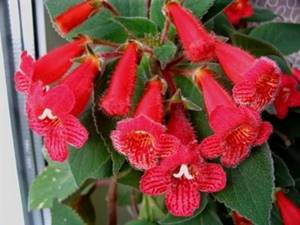
When watering, water should not get on leaves and flowers.
In autumn, watering is reduced, and in winter, the flower is watered when the top layer of soil has already become dry.
Top dressing
Feeding Kaleria is highly desirable during the period of growth and flowering. You can use special fertilizers for Saintpaulias or orchids, but diluted 2 times more than recommended in the instructions.
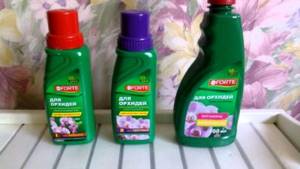
Orchid fertilizers can be used to feed Kaleria.
It is also possible to use any fertilizer for flowering indoor plants. Kaleria is fertilized once a month in spring and summer. During the dormant period, no feeding is required.
Vermicompost is also recommended; it is added before the formation of buds, it helps the development of lush foliage.
Crown formation
The Kaleria bush can be formed at the discretion of the owner. The plant can be “directed” along different paths and get an ampelous (hanging) or erect bushy plant. Trim the shoots before buds begin to form with sharp, disinfected scissors. The cut off tops can be used to create a new independent plant. To get an ampelous plant, you do not need to prune - the elongated shoots will begin to hang down under their own weight.
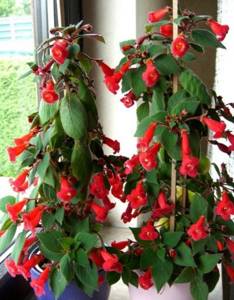
One way to position long shoots is to install a support
Flowering and dormancy
Kaleria blooms in summer, fades in September and prepares to retire until next spring. After flowering, all flower stalks and dried flowers should be removed. The foliage remains on the plant, so the bush can be left in the same place, only by lowering the temperature to 16–18 o C. Feeding stops, watering becomes less frequent.
Aloe flower is a house plant with long, thick and spiny leaves.
Aloe variegata (tiger aloe)
A typical succulent plant with long, spiny leaves, most often arranged in a rosette. Aloe variegata (tiger aloe) has light transverse stripes “painted” on the leaves, and the leaves themselves are arranged one above the other in a tight spiral. All species have only mature plants.
Family: Liliaceae (Lilyaceae).
Homeland: Africa.
The location for this long-leaved houseplant should be sunny; in summer it is best to place it outdoors in a sheltered place.
Temperature. Indoor, requires coolness in winter.
Air humidity: a flower with thick long leaves easily tolerates dry air.
Substrate. Flower soil mixture with 1/3 sand.
Watering. Maintain moderate soil moisture; Water less in winter.
Feeding. In summer, apply fertilizer for cacti every 3 weeks.
Transfer. Mature plants should be replanted if necessary.
Reproduction. Side shoots, shoot cuttings or seeds.
Pests, diseases: Phylloxera.
Important! Avoid stagnant waterlogging. Place a layer of sand or perlite about 5 cm thick on the surface of the substrate - this will prevent the lower part of the stem from rotting
Look at this indoor plant with long leaves in the photo, which shows mature and well-formed specimens:
Reproduction
The optimal time for plant propagation is spring. Although, if necessary, this can be done in other seasons.
There are several ways to propagate this plant. Leaf propagation is rarely used - it takes too long to wait for roots to appear (up to 5 months).
By dividing the rhizome
- When transplanting, divide the rhizome into several parts (preferably no more than 3) with a sharp knife.
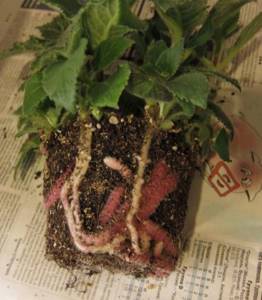
When transplanting, the rhizome is divided into 2–3 parts
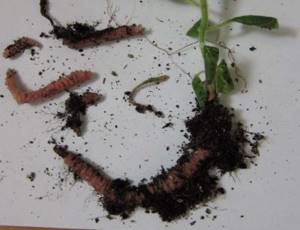
Pieces of rhizome are planted in different pots
Seeds
- To obtain Kaleria seeds, it is necessary to use artificial pollination. They can also be purchased.
- Seeds are planted in the second half of winter.
- A mixture of peat and sand is required (or 1 part sand and 2 parts sheet soil).
- The seeds are simply placed on the soil without deepening them.
- Cover the pot with polyethylene.
- Ventilate daily to prevent mold from appearing. Water periodically.
- When the seedlings have 2 leaves, the seedlings are picked and planted in separate containers.
- After the seedlings have grown, the top bud is removed to stimulate the development of side shoots.
By cuttings
- Prepare the cuttings by cutting off the top of the stems.
- Powder the sections with Kornevin.
- Place in water (heating from below will speed up the appearance of roots).
- When the roots appear, plant in a small pot (required soil: sand or a mixture of peat and sand).
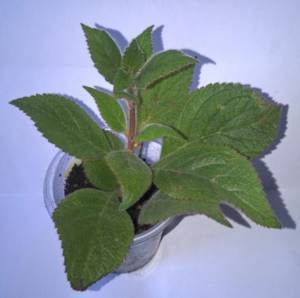
Kaleria grown from cuttings
Reviews from flower growers about growing
Kaleria - when you pronounce this name, it seems to roll on your tongue. It’s been growing for me for many years and I can’t get enough of it, I can admire it all day long. Kaleria is not too whimsical, but loves a sunny window sill and does not tolerate drafts at all. But it grows and blooms almost continuously. And what beautiful flowers she has! The shape of the flower resembles a bell with an unusual spotted red coloring. And this beautiful flower reproduces very simply - after flowering, you need to cut off the top and put it in water. And after the first roots appear, feel free to plant them in a pot of soil. I always take ordinary garden soil; all my indoor plants grow and bloom just fine in it. You need to water the kaleria very carefully, trying not to get water on the leaves, as this will cause them to rot. If you follow these simple rules, this beauty will bring you many pleasant moments and lift your spirits.
pomidorastr https://citykey.net/review/podnimaet-nastroenie
The coloring must be formed from a small cutting. As soon as a 5-centimeter shoot appears, we begin to pinch. It will branch and form into a bush. This will delay flowering a little.
Nika https://forum.bestflowers.ru/t/kolerija-kohleria.1996/page-11
It should rest in a cool, dark place in winter, I put it in a black bag and put it under the balcony door, in January-February I take it out and, very carefully, so as not to overwater it and ruin it, I start watering it.
Irena_Obninsk https://forum.myjane.ru/viewtopic.php?t=37708
Sunny lighting, abundant watering, does not tolerate spraying, no pruning required, propagation by apical cuttings or root division, fertilizing from spring to autumn every 2–4 weeks. Good luck! The flower is gorgeous, but harmful.
dormidont https://otvet.mail.ru/question/43039137
Kaleria is perfect for growing at home. It does not require frequent watering, any special conditions of maintenance, lighting, or humidity. And beautiful flowers delight the owners for quite a long time.
Indoor pomegranate
Pomegranate is a subtropical plant suitable for growing as an ornamental houseplant. With proper care, it will not only bloom, but also bear fruit. It looks like a tree with numerous thin branches with thin thorns. The leaves are small, elongated, pointed at the ends.
The pomegranate flower has an unusual shape, with a hard red perianth covering the inner petals, which are yellow, white or bright scarlet, depending on the variety.
Dwarf species suitable for growing at home:
- Ruby;
- Baby;
- Uzbekistan;
- Nana.
These varieties have a height of 50 to 100 cm. You can grow a seedling from a seed, but you will not be able to get good fruits, since hybrids are grown for sale. The main difference between dwarf varieties and garden varieties is that they do not shed their leaves for the winter. Pomegranate blooms for a long time, from April to the end of summer. The flowers look like bells or water lilies and are self-pollinating. After flowering, edible fruits are set.
